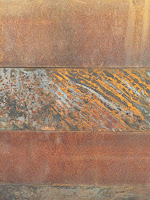 |
| Sean Scully, Wall Bloom, 2016 |
In yet
another wonderful exhibition at Galerie Lelong, this selection of works by the Irish-American
artist Sean Scully’s gleams brightly as we approach the gallery space. The
distinction of these paintings is their support: steel, aluminium and copper. I
had no idea how radically the support can change not just the substance of
painting, but the context, meaning, and understanding of the medium applied to
it. This is to say nothing of the veritable luminosity given to works in which
steel and paint merge on the surface.
Scully’s
work is often talked about for its reference to natural landscapes and/or
built environments. This is because it’s the discourse he gives to the vertical
and horizontal colour bands, blocks and stripes that have filled his canvases
for more than fifty years. While these narratives may explain Scully’s vast
body of works on canvas, everything changes with the use of metal supports.
From the start, when paint is applied to metal, the result is always about speed, surface, and transparency. Standing
before the paintings we see paint and steel coming together to create something
that exists nowhere but on the surface of the paintings – unless we want to
call them painted sculpture. We see brushstrokes sliding across and over the
surface, turning, changing their minds, abruptly stopping and moving elsewhere.
 |
| Sean Scully, Wall Brown Pink, 2015 |
The
resultant effect of paint on steel are works in which the paint becomes
distilled to strokes that reminded me of Roy Lichtenstein’s giant brushstrokes.
Somewhere between abstract expressionism and pop art, paint on metal in Scully's works is luscious and simultaneously empty. I never got the sense that there
was anything behind the strokes. Gone are the order and symmetry that so often
forced the viewing of Scully’s works on canvas, and in their place, a whole different
set of rhythms and movements are introduced by steel, copper and aluminium.
While on
the one hand, metal reduces paint to sliding strokes, on the other hand, the
two, sculpture and painting become fused. The merger of sculpture and painting
in the works on the walls is confirmed by the sumptuous colours of a rusted
corten steel column in the middle of the exhibition. The sculpture is made of
layers of steel placed one in top of the other, each panel clearly having lived
a different history from the others. Each horizontal strips of rusted steel is quite different, and thereby, becomes like the building blocks of paint on the works on the walls. Paint and steel thus are
fused, interchangeable.
 |
| Sean Scully, Figure, 2013 |
Lastly, I
have to say, my favourite piece in the exhibition was a stunning work called Figure from 2013. Grey of varying darkness and
density blocks are hastily painted on an aluminium ground. The dripping paint at
the bottom of the painted area, the uneven edges, and the luminosity of grey on
aluminium made paint as colour float above what appeared to be rubbed metal. There was
something Rothko-like in the tension between three-dimensional shapes on a
two-dimensional surface without Rothko's fastidious working over. The effect is one that shows Scully’s ability to create absence of all reference to substance, to
anything behind the surface, removing all depth to the image, and simultaneously, filling it with movement, drama and dimensionality.




No comments:
Post a Comment